Weathered Cortex of Eluvial–Deluvial Jadeite Jade from Myanmar: Its Features, Formation Mechanism, and Implications
Abstract
:1. Introduction
2. Geologic Background
3. Materials and Methods
4. Results
5. Discussion
6. Conclusions
- The textural and mineralogical changes in the cortex cause optical interfaces and greatly decrease the transparency, indicating that some elements and components of the minerals have been removed from the cortex. While some neo-minerals (gibbsite, kaolinite, and halloysite) formed as the residual phases of the jadeite, the Fe-bearing colloidal minerals are inferred to have been incorporated from the surrounding environment during the weathering process.
- The yellow-brown and black weathered cortexes may be meaningless in terms of predicting the color of the inner jade body based on the color of the weathered cortex. However, they contain valuable information for estimating the depth and oxidizing-reducing conditions of the location from which the jade piece was mined.
- Since the grain sizes and textures of the weathered cortex and jade body of a piece of jadeite are basically identical, it is possible to predict the grain size of the inner fresh jade by scrutinizing the texture of the cortex. However, too-small size in a certain cortex is not a necessary indication for very fine grain texture of its inner jade body.
- Studies of the weathering process on monomineralic jadeite stones would have implications for identifying their origin, understanding their gemmological utilities, and understanding the differences in the weathering processes from rocks consisting of multiple minerals.
Supplementary Materials
Author Contributions
Funding
Acknowledgments
Conflicts of Interest
References
- Shi, G.; Wang, X.; Chu, B.; Cui, W. Jadeite jade from Myanmar: Its texture and gemmological implications. J. Gemmol. 2009, 31, 185–195. [Google Scholar] [CrossRef]
- Wang, Z.Z.; Xu, W.C.; Zhang, J.Y. Gambling on raw jadeite. Liaoning Geol. 2000, 17, 156–157. [Google Scholar]
- Pan, J. Classification of raw jadeite (gambling jadeite). J. Gems Gemmol. 2014, 16, 12–23. [Google Scholar] [CrossRef]
- Zhang, W.J. The epigentic geochemistry of Feicui and its application. Yunnan Geol. 1998, 17, 387–391. [Google Scholar]
- Zhang, E.; Yin, X.L.; Peng, M.S. Discussion on character of the rough jadeite crust. Bull. Mineral. Petrol. Geochem. 1999, 18, 400–402. [Google Scholar]
- Zhang, W.J. Jadeite deposit geology in Pharkant area, north Myanmar. Yunnan Geol. 2002, 21, 378–390. [Google Scholar] [CrossRef]
- Chen, B.H.; Luo, Q.K.; Hao, W.J. Preliminary study on components of crust of jadeite jade and its relationship with interior jade quality. J. Gems Gemmol. 2009, 11, 16–19. [Google Scholar] [CrossRef]
- Hu, C.Y.; Chen, Z.H. Gemmological significance of study on secondary reducing fluid-rock interaction in jadeite jade bench deposit from Burma. J. Gems Gemmol. 2002, 4, 1–7. [Google Scholar] [CrossRef]
- Yan, W.W.; Wang, J.H. A study on compositional variation of the secondary jadeite jade from Myanmar. Acta Mineral. Sin. 2014, 34, 60–66. [Google Scholar]
- Shi, G.; Cui, W.; Cao, S.; Jiang, N.; Jian, P.; Liu, D.; Miao, L.; Chu, B. Ion microprobe zircon U–Pb age and geochemistry of the Myanmar jadeitite. J. Geol. Soc. Lond. 2008, 165, 221–234. [Google Scholar] [CrossRef]
- Shi, G.; Lei, W.; He, H.; Ng, Y.N.; Liu, Y.; Liu, Y.; Yuan, Y.; Kang, Z.; Xie, G. Superimposed tectono-metamorphic episodes of Jurassic and Eocene age in the jadeite uplift, Myanmar, as revealed by 40Ar/39Ar dating. Gondwana Res. 2014, 26, 464–474. [Google Scholar] [CrossRef]
- Mitchell, A.H.G.; Htay, M.T.; Htun, K.M.; Win, M.N.; Oo, T.; Hlaing, T. Rock relationships in the Mogok metamorphic belt, Tatkon to Mandalay, central Myanmar. J. Asian Earth Sci. 2007, 29, 891–910. [Google Scholar] [CrossRef]
- Searle, M.P.; Noble, S.R.; Cottle, J.M.; Waters, D.J.; Mitchell, A.H.G.; Hlaing, T.; Horstwood, M.S.A. Tectonic evolution of the Mogok metamorphic belt, Burma (Myanmar) constrained by U-Th-Pb dating of metamorphic and magmatic rocks. Tectonics 2007, 26, TC3014. [Google Scholar] [CrossRef]
- Chhibber, H.L. The Mineral Resources of Burma; MacMillan: London, UK, 1934. [Google Scholar]
- Shi, G.-H.; Cui, W.-Y.; Tropper, P.; Wang, C.-Q.; Shu, G.-M.; Yu, H. The petrology of a complex sodic and sodic-calcic amphibole association and its implications for the metasomatic processes in the jadeitite area in northwestern Myanmar, formerly Burma. Contrib. Mineral. Petrol. 2003, 145, 355–376. [Google Scholar] [CrossRef]
- Morimoto, N.; Fabries, J.; Ferguson, A.K.; Ginzburg, I.V.; Ross, M.; Seifert, F.A.; Zussman, J.; Aoki, K.; Gottardi, D. Nomenclature of pyroxenes. Am. Mineral. 1988, 14, 198–221. [Google Scholar] [CrossRef] [Green Version]
- Shi, G.; Jiang, N.; Wang, Y.; Zhao, X.; Wang, X.; Li, G.; Ng, E.; Cui, W. Ba minerals in clinopyroxene rocks from the Myanmar jadeitite area: Implications for Ba recycling in subduction zones. Eur. J. Mineral. 2010, 22, 199–214. [Google Scholar] [CrossRef] [Green Version]
- Wang, M.; Shi, G. The evolution of Chinese jade carving craftmanship. Gems Gemol. 2020, 56, 30–53. [Google Scholar] [CrossRef]
- Xing, B.Q.; Shi, G.H.; Zhang, J.H.; Long, C.; Zhang, Y.; He, L.Y.; Hu, R.J. Characteristics of the Guatemalan Feicui and its comparison to the Myanmar Feicui. Geoscience 2021, 35, 1769–1788. [Google Scholar] [CrossRef]
- Jiang, Y.; Shi, G.; Xu, L.; Li, X. Mineralogy and geochemistry of nephrite jade from Yinggelike Deposit, Altyn Tagh (Xinjiang, NW China). Minerals 2020, 10, 418. [Google Scholar] [CrossRef]
- Wang, J.; Shi, G. Comparative study on the origin and characteristics of Chinese (Manas) and Russian (East Sayan) green nephrites. Minerals 2021, 11, 1434. [Google Scholar] [CrossRef]

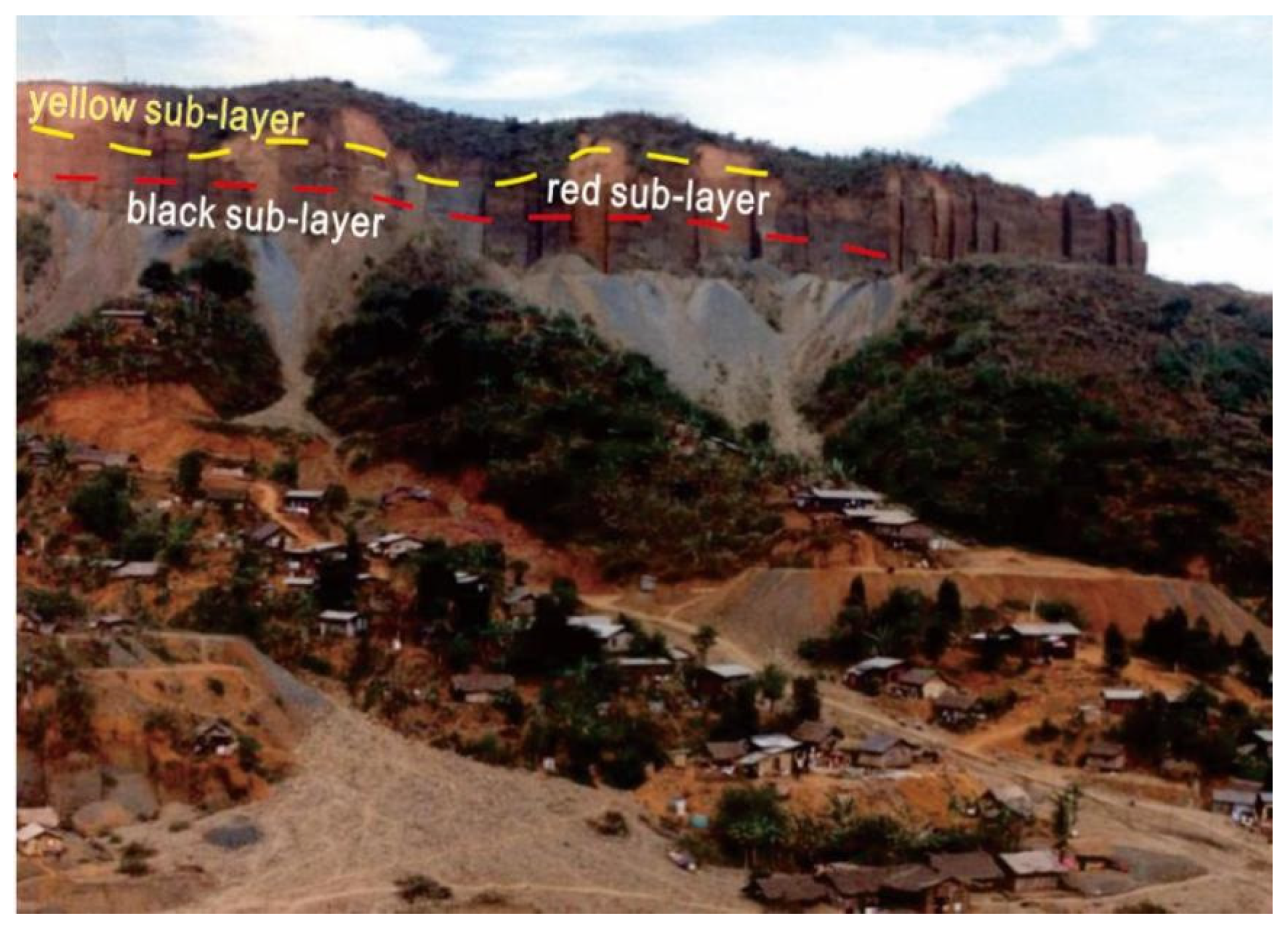

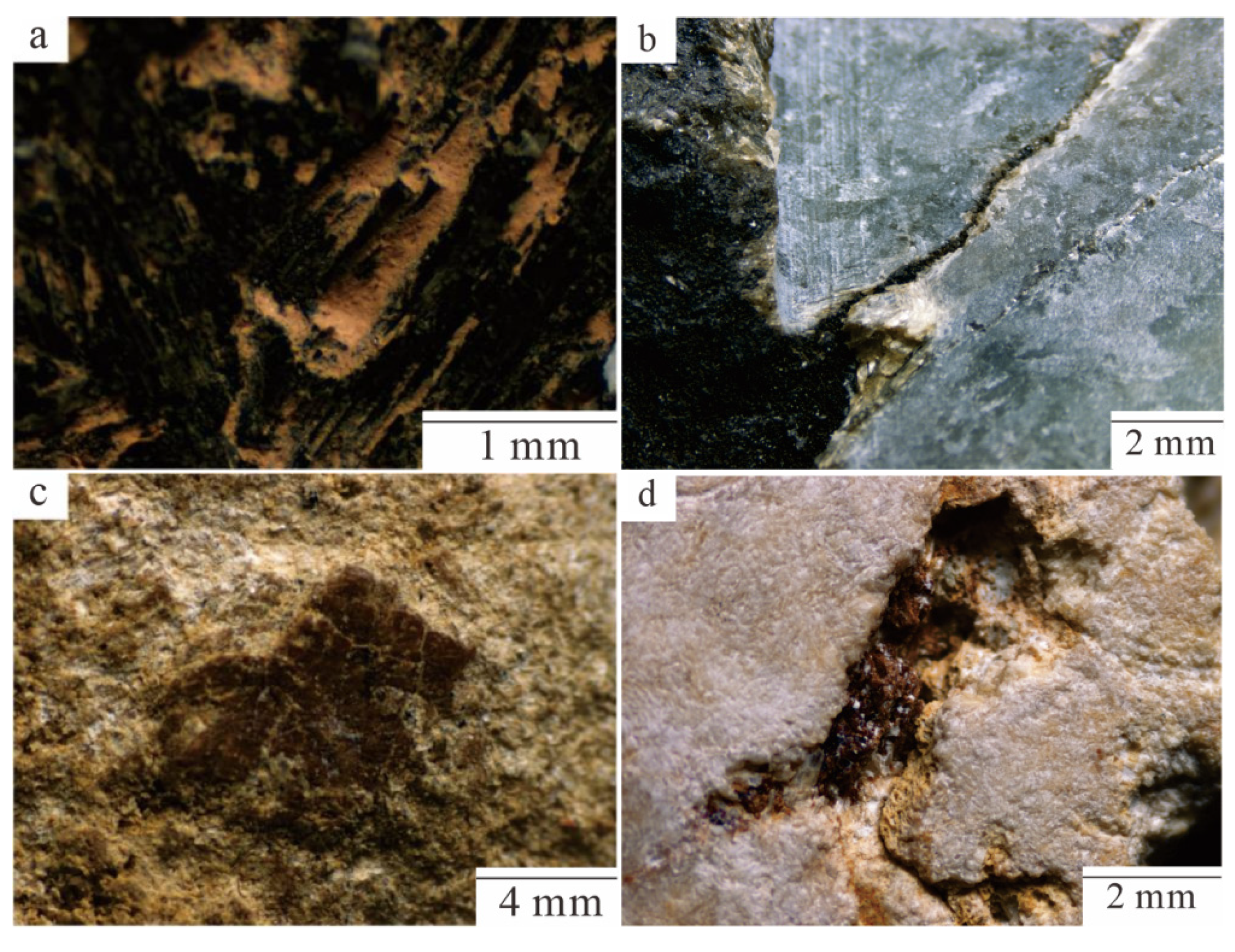
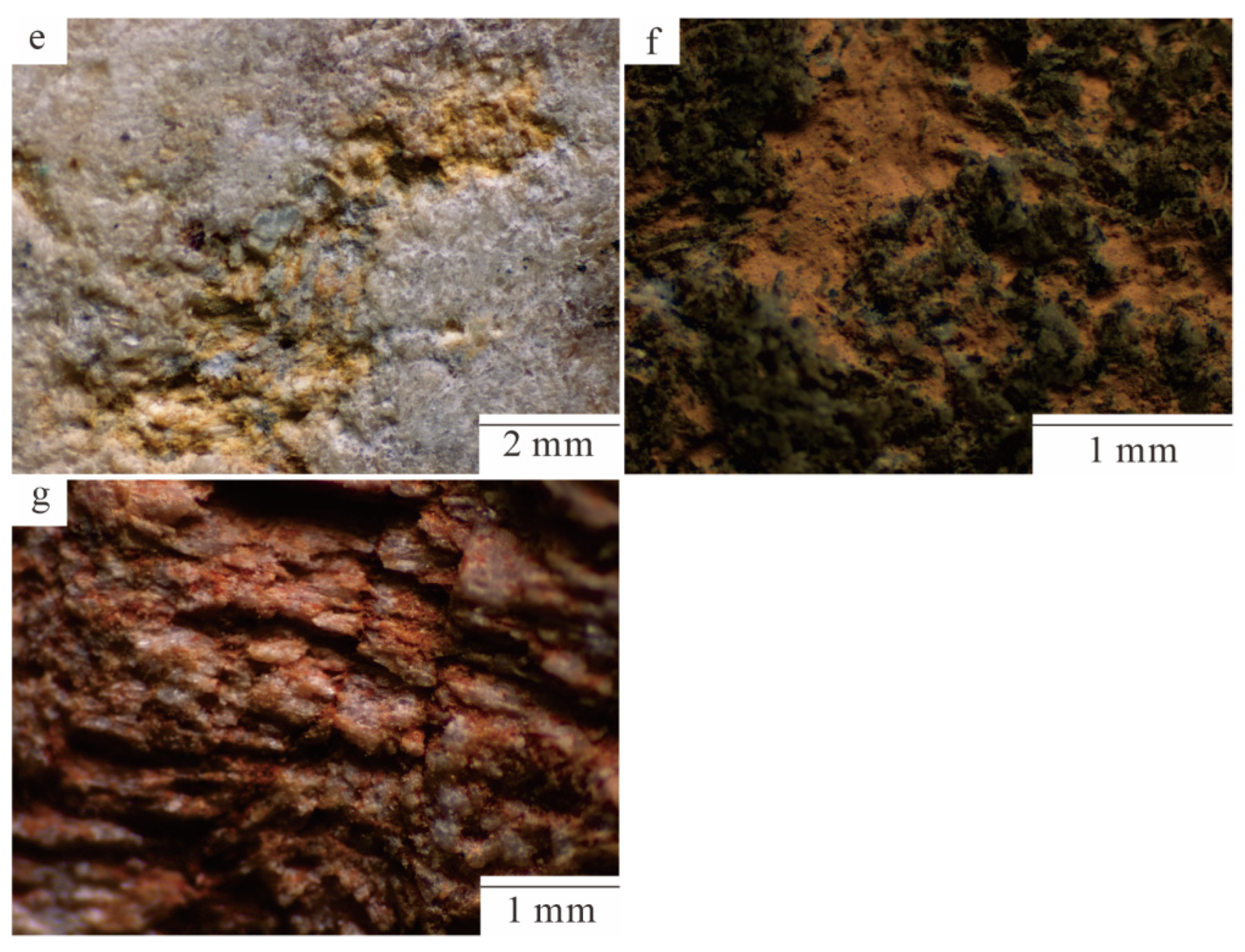
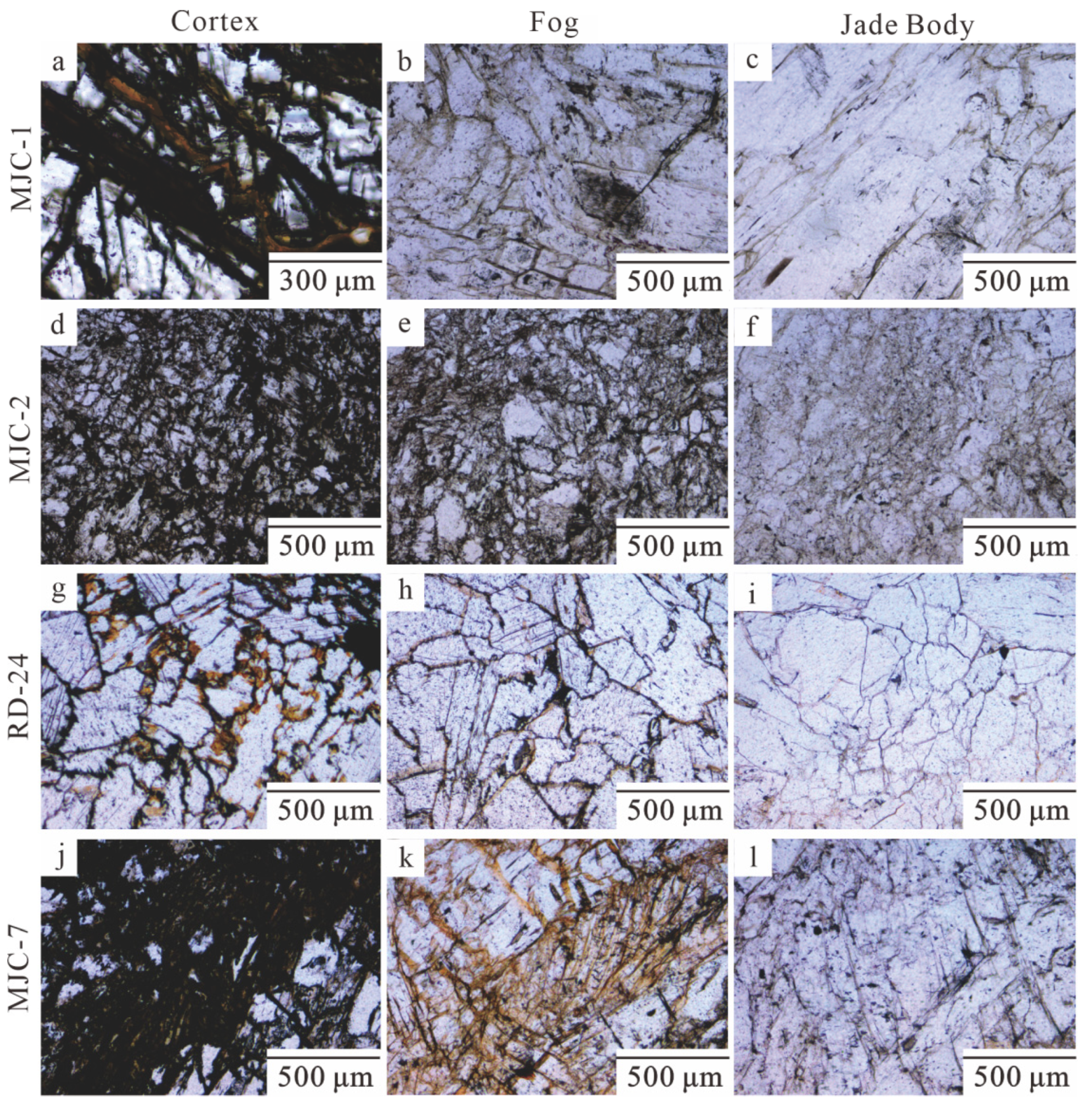
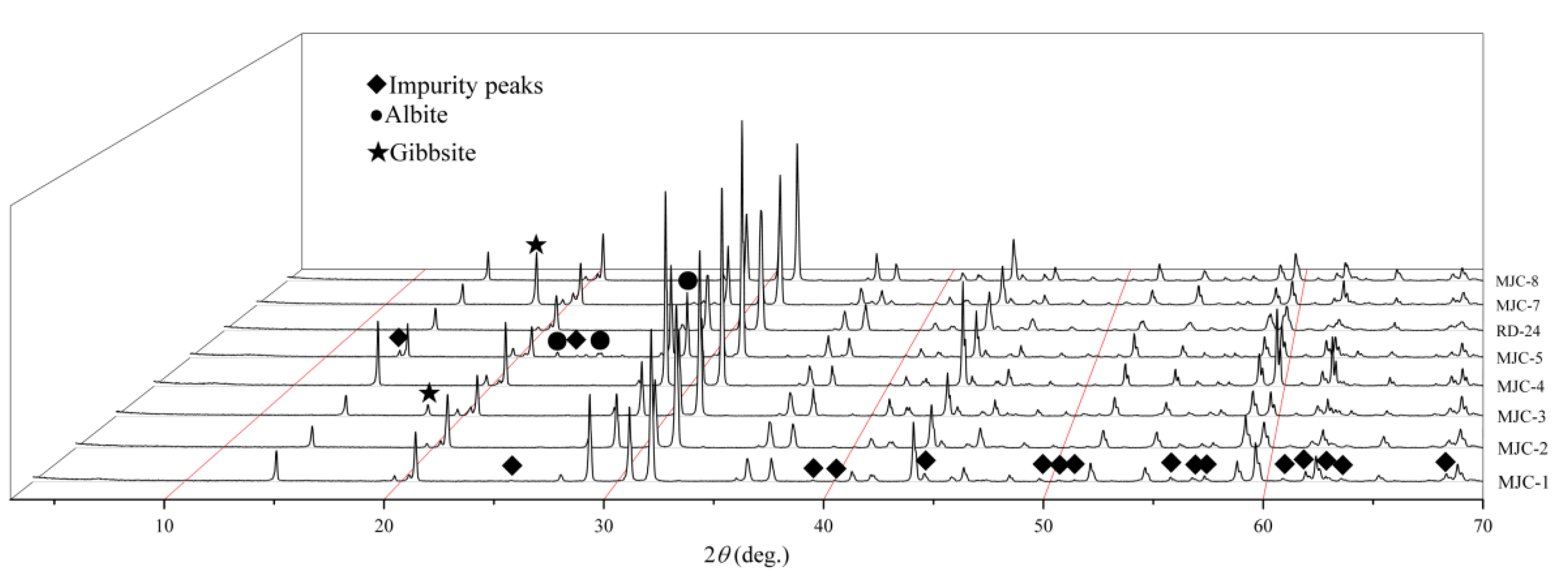
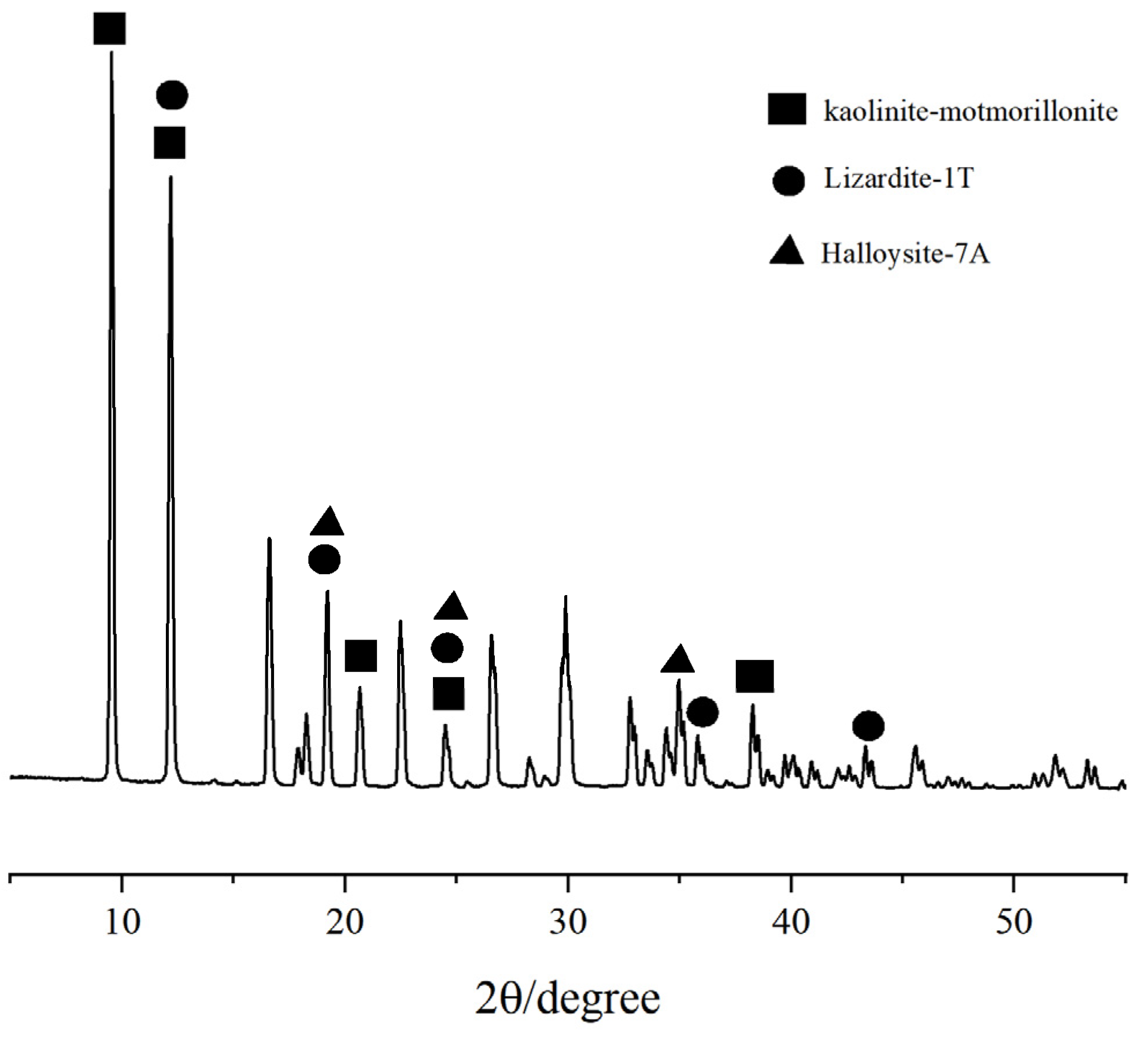


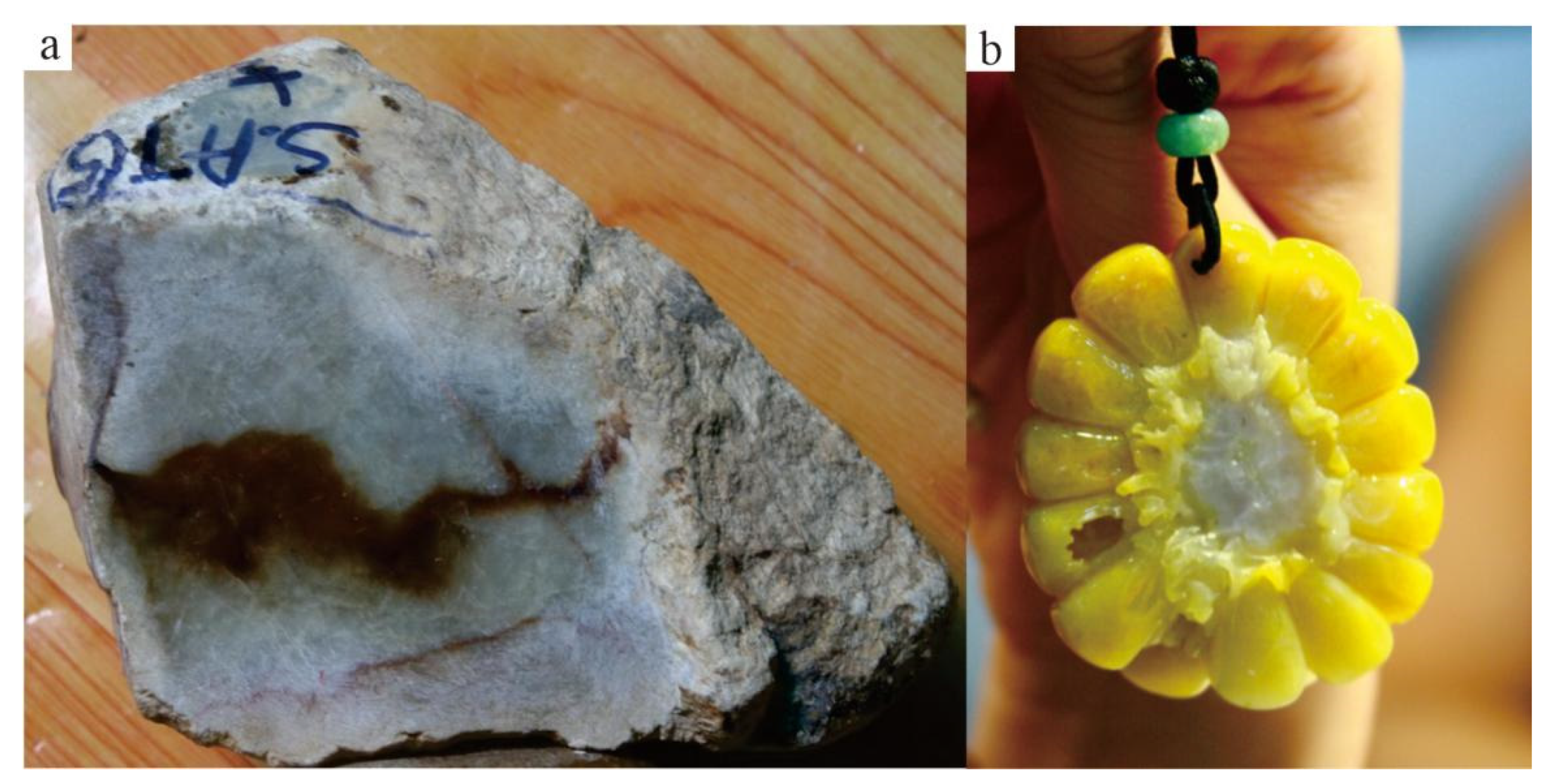
| Sample | MJC-1 | MJC-2 | MJC-3 | MJC-5 | RD-24 | MJC-7 | |||||||||||||
|---|---|---|---|---|---|---|---|---|---|---|---|---|---|---|---|---|---|---|---|
| No. | 1 | 2 | 3 | 4 | 5 | 1 | 2 | 3 | 1 | 1 | 2 | 1 | 2 | 1 | 2 | 3 | 4 | 5 | 6 |
| SiO2 | 28.13 | 58.94 | 59.24 | 59.02 | 58.53 | 59.62 | 58.84 | 58.42 | 0.68 | 57.74 | 59.17 | 59.08 | 58.45 | 58.85 | 58.75 | 59.18 | 59.14 | 57.49 | 58.90 |
| TiO2 | 0.00 | 0.07 | 0.00 | 0.03 | 0.07 | 0.00 | 0.12 | 0.00 | 0.09 | 0.00 | 0.02 | 0.00 | 0.11 | 0.09 | 0.07 | 0.00 | 0.03 | 0.19 | 0.02 |
| Al2O3 | 16.00 | 23.43 | 23.74 | 23.78 | 24.03 | 23.78 | 22.23 | 23.65 | 64.35 | 20.40 | 23.81 | 23.90 | 24.74 | 24.38 | 24.02 | 24.83 | 24.58 | 20.80 | 24.33 |
| Cr2O3 | 0.00 | 0.00 | 0.00 | 0.00 | 0.00 | 0.00 | 0.00 | 0.00 | 0.00 | 2.69 | 0.00 | 0.00 | 0.00 | 0.00 | 0.00 | 0.00 | 0.00 | 0.00 | 0.00 |
| FeO | 36.20 | 0.45 | 0.52 | 0.22 | 0.09 | 0.33 | 1.07 | 0.45 | 0.42 | 0.41 | 0.57 | 0.21 | 0.32 | 0.18 | 0.39 | 0.19 | 0.22 | 1.55 | 0.30 |
| MnO | 0.45 | 0.03 | 0.00 | 0.00 | 0.00 | 0.00 | 0.00 | 0.08 | 0.00 | 0.13 | 0.08 | 0.11 | 0.00 | 0.00 | 0.09 | 0.00 | 0.00 | 0.00 | 0.08 |
| MgO | 3.69 | 0.94 | 0.55 | 0.65 | 0.70 | 0.62 | 1.45 | 0.66 | 0.00 | 1.69 | 0.59 | 0.64 | 0.10 | 0.26 | 0.15 | 0.08 | 0.06 | 2.11 | 0.33 |
| CaO | 0.38 | 1.38 | 0.70 | 0.92 | 1.05 | 1.20 | 1.97 | 1.17 | 0.00 | 2.23 | 0.81 | 0.91 | 0.24 | 0.54 | 0.24 | 0.14 | 0.22 | 3.01 | 0.62 |
| Na2O | 0.37 | 14.71 | 15.11 | 15.24 | 15.07 | 14.88 | 14.42 | 14.78 | 0.00 | 14.24 | 15.10 | 15.15 | 15.48 | 15.24 | 15.18 | 15.51 | 15.52 | 13.60 | 15.22 |
| K2O | 0.00 | 0.01 | 0.01 | 0.00 | 0.22 | 0.32 | 0.00 | 0.26 | 0.00 | 0.00 | 0.02 | 0.03 | 0.22 | 0.09 | 0.00 | 0.00 | 0.03 | 0.00 | 0.00 |
| Total | 85.22 | 99.96 | 99.87 | 99.86 | 99.76 | 100.75 | 100.10 | 99.47 | 65.54 | 99.53 | 100.17 | 100.03 | 99.66 | 99.63 | 98.89 | 99.93 | 99.80 | 98.75 | 99.80 |
| Si | 3.34 | 1.99 | 2.00 | 1.99 | 1.97 | 2.00 | 1.99 | 1.98 | 1.98 | 1.99 | 1.99 | 1.97 | 1.99 | 2.00 | 1.99 | 1.99 | 1.98 | 1.99 | |
| AlIV | 0.66 | 0.01 | 0.00 | 0.01 | 0.03 | 0.00 | 0.01 | 0.02 | 0.02 | 0.01 | 0.01 | 0.03 | 0.01 | 0.00 | 0.01 | 0.01 | 0.02 | 0.01 | |
| Ti | 0.00 | 0.00 | 0.00 | 0.00 | 0.00 | 0.00 | 0.00 | 0.00 | 0.00 | 0.00 | 0.00 | 0.00 | 0.00 | 0.00 | 0.00 | 0.00 | 0.00 | 0.00 | |
| T | 4.00 | 2.00 | 2.00 | 2.00 | 2.00 | 2.00 | 2.00 | 2.00 | 2.00 | 2.00 | 2.00 | 2.00 | 2.00 | 2.00 | 2.00 | 2.00 | 2.00 | 2.00 | |
| AlVI | 1.58 | 0.92 | 0.94 | 0.93 | 0.92 | 0.94 | 0.88 | 0.93 | 0.80 | 0.93 | 0.94 | 0.95 | 0.96 | 0.96 | 0.97 | 0.97 | 0.82 | 0.96 | |
| Fe | 3.59 | 0.01 | 0.01 | 0.01 | 0.00 | 0.01 | 0.03 | 0.01 | 0.01 | 0.02 | 0.01 | 0.01 | 0.01 | 0.01 | 0.01 | 0.01 | 0.04 | 0.01 | |
| Cr | 0.00 | 0.00 | 0.00 | 0.00 | 0.00 | 0.00 | 0.00 | 0.00 | 0.07 | 0.00 | 0.00 | 0.00 | 0.00 | 0.00 | 0.00 | 0.00 | 0.00 | 0.00 | |
| Mg | 0.00 | 0.05 | 0.03 | 0.03 | 0.04 | 0.03 | 0.07 | 0.03 | 0.09 | 0.03 | 0.03 | 0.01 | 0.01 | 0.01 | 0.00 | 0.00 | 0.11 | 0.02 | |
| M1 | 0.98 | 0.98 | 0.97 | 0.96 | 0.98 | 0.98 | 0.97 | 0.97 | 0.98 | 0.98 | 0.97 | 0.98 | 0.98 | 0.98 | 0.98 | 0.97 | 0.99 | ||
| Mn | 0.05 | 0.00 | 0.00 | 0.00 | 0.00 | 0.00 | 0.00 | 0.00 | 0.00 | 0.00 | 0.00 | 0.00 | 0.00 | 0.00 | 0.00 | 0.00 | 0.00 | 0.00 | |
| Mg | 0.65 | 0.00 | 0.00 | 0.00 | 0.00 | 0.00 | 0.00 | 0.00 | 0.00 | 0.00 | 0.00 | 0.00 | 0.00 | 0.00 | 0.00 | 0.00 | 0.00 | 0.00 | |
| Fe | 0.00 | 0.00 | 0.00 | 0.00 | 0.00 | 0.00 | 0.00 | 0.00 | 0.00 | 0.00 | 0.00 | 0.00 | 0.00 | 0.00 | 0.00 | 0.00 | 0.00 | ||
| Ca | 0.01 | 0.05 | 0.03 | 0.03 | 0.04 | 0.04 | 0.07 | 0.04 | 0.08 | 0.03 | 0.03 | 0.01 | 0.02 | 0.01 | 0.01 | 0.01 | 0.11 | 0.02 | |
| Na | 0.09 | 0.96 | 0.99 | 1.00 | 0.99 | 0.97 | 0.95 | 0.97 | 0.94 | 0.99 | 0.99 | 1.01 | 1.00 | 1.00 | 1.01 | 1.01 | 0.91 | 1.00 | |
| K | 0.00 | 0.00 | 0.00 | 0.00 | 0.01 | 0.01 | 0.00 | 0.01 | 0.00 | 0.00 | 0.00 | 0.01 | 0.00 | 0.00 | 0.00 | 0.00 | 0.00 | 0.00 | |
| M2 | 1.01 | 1.02 | 1.03 | 1.04 | 1.02 | 1.02 | 1.02 | 1.02 | 1.02 | 1.02 | 1.03 | 1.02 | 1.01 | 1.02 | 1.02 | 1.02 | 1.02 | ||
| Quad | 0.05 | 0.03 | 0.03 | 0.04 | 0.04 | 0.07 | 0.04 | 0.08 | 0.03 | 0.03 | 0.01 | 0.02 | 0.01 | 0.00 | 0.01 | 0.11 | 0.02 | ||
| Jd | 0.94 | 0.96 | 0.96 | 0.96 | 0.95 | 0.90 | 0.95 | 0.91 | 0.95 | 0.96 | 0.98 | 0.98 | 0.98 | 0.99 | 0.99 | 0.85 | 0.97 | ||
| Ae | 0.01 | 0.01 | 0.01 | 0.00 | 0.01 | 0.03 | 0.01 | 0.01 | 0.02 | 0.01 | 0.01 | 0.01 | 0.01 | 0.01 | 0.01 | 0.04 | 0.01 | ||
| Mieral | Chl | Jd | Jd | Jd | Jd | Jd | Jd | Jd | Gbs | Jd | Jd | Jd | Jd | Jd | Jd | Jd | Jd | Jd | Jd |
Publisher’s Note: MDPI stays neutral with regard to jurisdictional claims in published maps and institutional affiliations. |
© 2022 by the authors. Licensee MDPI, Basel, Switzerland. This article is an open access article distributed under the terms and conditions of the Creative Commons Attribution (CC BY) license (https://creativecommons.org/licenses/by/4.0/).
Share and Cite
Zhang, X.; Shi, G.; Li, G.; Li, X. Weathered Cortex of Eluvial–Deluvial Jadeite Jade from Myanmar: Its Features, Formation Mechanism, and Implications. Minerals 2022, 12, 797. https://doi.org/10.3390/min12070797
Zhang X, Shi G, Li G, Li X. Weathered Cortex of Eluvial–Deluvial Jadeite Jade from Myanmar: Its Features, Formation Mechanism, and Implications. Minerals. 2022; 12(7):797. https://doi.org/10.3390/min12070797
Chicago/Turabian StyleZhang, Xiangyu, Guanghai Shi, Guowu Li, and Xin Li. 2022. "Weathered Cortex of Eluvial–Deluvial Jadeite Jade from Myanmar: Its Features, Formation Mechanism, and Implications" Minerals 12, no. 7: 797. https://doi.org/10.3390/min12070797
APA StyleZhang, X., Shi, G., Li, G., & Li, X. (2022). Weathered Cortex of Eluvial–Deluvial Jadeite Jade from Myanmar: Its Features, Formation Mechanism, and Implications. Minerals, 12(7), 797. https://doi.org/10.3390/min12070797







